The rustic kitchen aesthetic continues to evolve in 2025, blending traditional charm with modern functionality. Today's rustic kitchen designs embrace natural materials, weathered finishes, and authentic textures while incorporating contemporary conveniences and sophisticated styling. From log cabin retreats to industrial farmhouse spaces, these design approaches celebrate the beauty of imperfection and the warmth of natural elements. Whether you're drawn to reclaimed wood cabinetry, exposed beam ceilings, or stone accent walls, rustic kitchens offer endless possibilities for creating inviting spaces that feel both timeless and current.
1. Traditional Farmhouse Rustic Kitchen with Shiplap Details
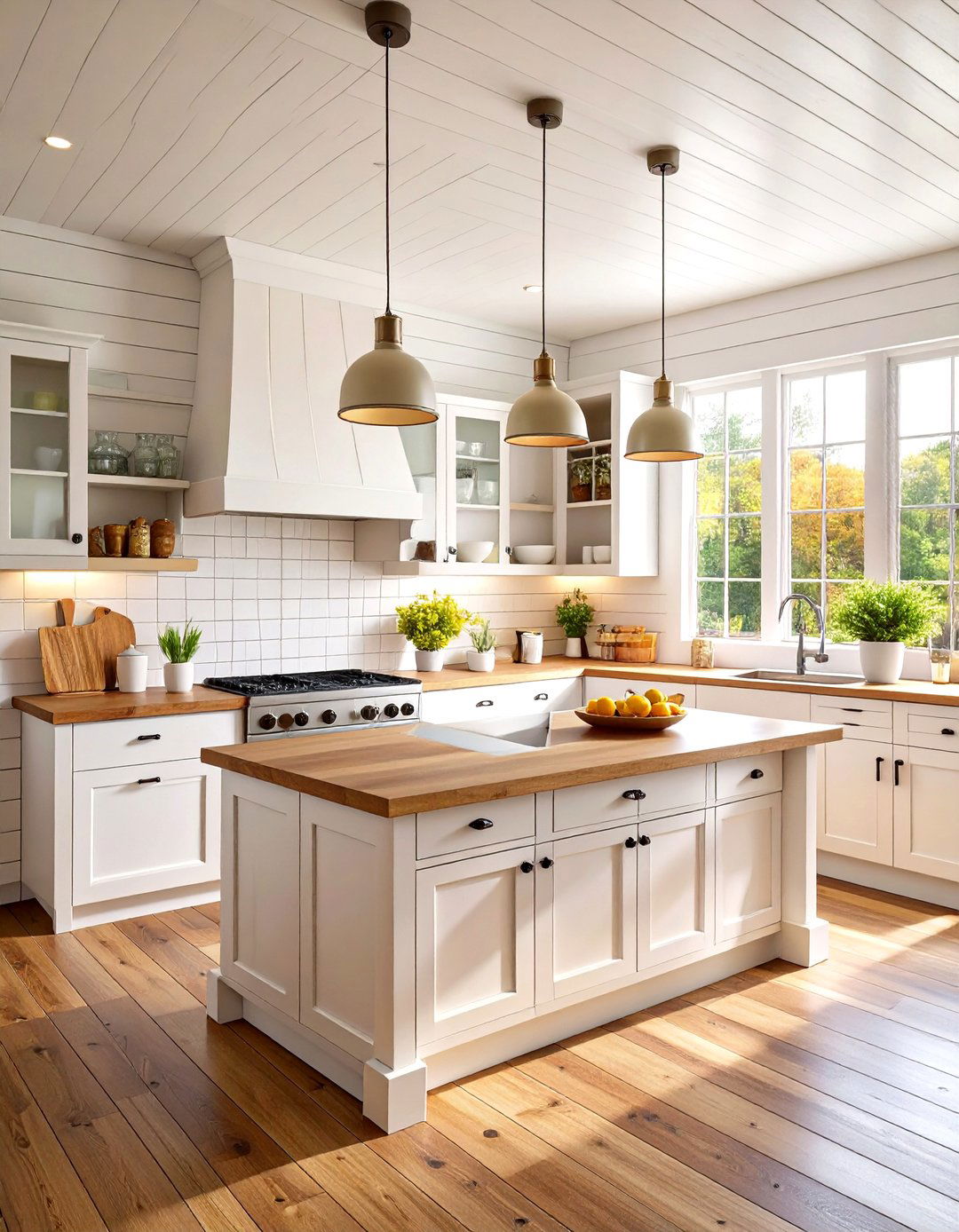
The quintessential farmhouse rustic kitchen centers around white or cream shaker-style cabinets paired with classic shiplap walls that extend from floor to ceiling. This design features a large farmhouse sink positioned beneath casement windows, complemented by butcher-block countertops that showcase natural wood grain patterns. Vintage-inspired pendant lighting with galvanized or brass finishes illuminates the central island, while open shelving displays ceramic dishware and mason jar collections. The color palette remains predominantly neutral with warm white walls, natural wood tones, and subtle pops of sage green or dusty blue through textiles and accessories. Wide-plank hardwood floors in honey or weathered oak complete this timeless aesthetic that perfectly balances rustic charm with everyday functionality.
2. Modern Rustic Kitchen with Clean Lines and Natural Elements
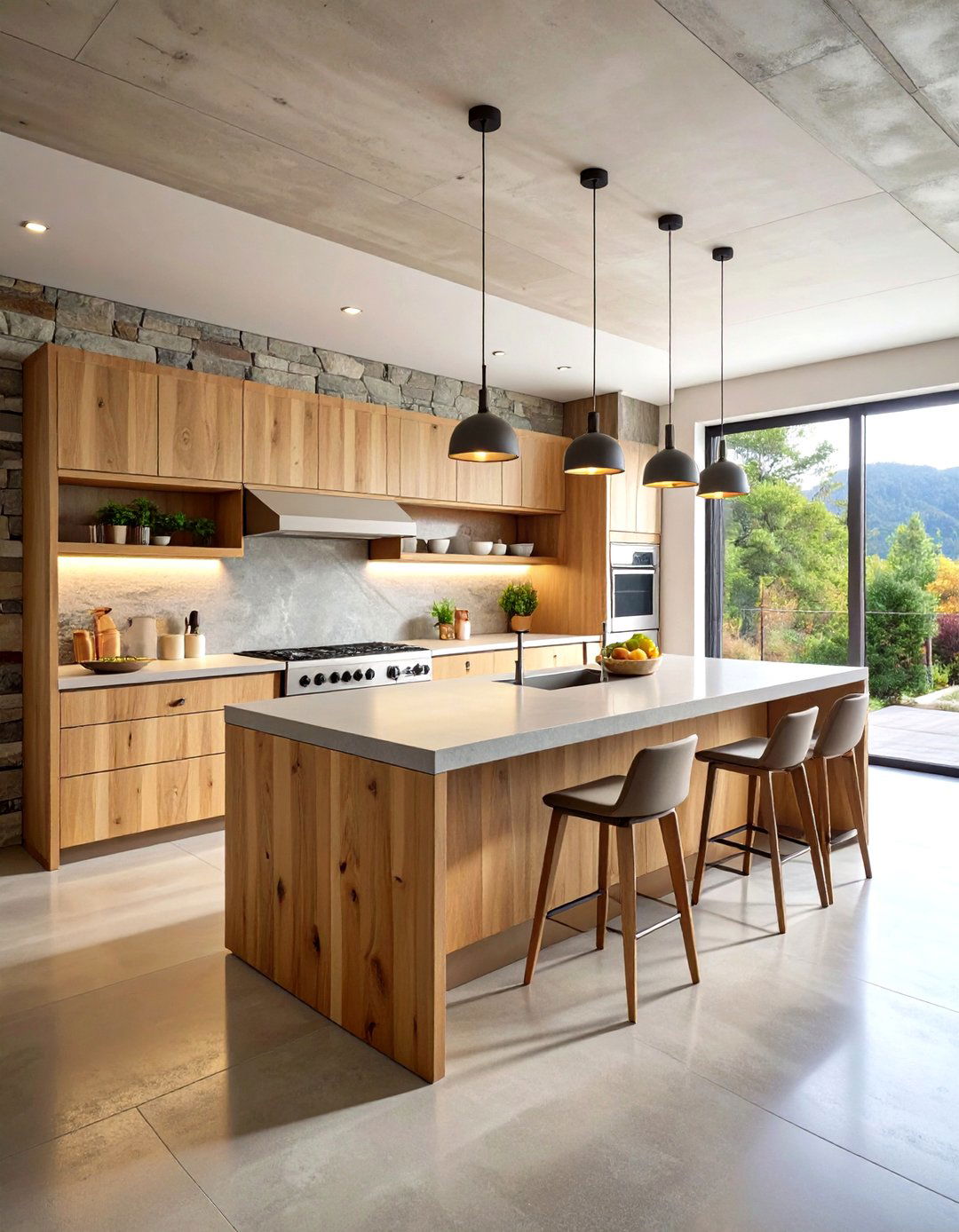
This contemporary interpretation of rustic kitchen design combines sleek, handleless cabinetry in warm wood tones with polished concrete countertops and stainless steel appliances. The design maintains rustic authenticity through carefully selected natural materials, including live-edge wood shelving and stone accent walls, while embracing minimalist principles through uncluttered surfaces and streamlined storage solutions. Large format windows maximize natural light, highlighting the interplay between smooth and textured surfaces throughout the space. Industrial-inspired pendant lights in matte black or brushed brass provide task lighting over the waterfall-edge island. The color scheme balances warm browns and grays with crisp whites, creating a sophisticated yet welcoming environment that appeals to those seeking rustic warmth without sacrificing modern convenience and style.
3. Log Cabin Rustic Kitchen with Exposed Timber Construction

The authentic log cabin rustic kitchen showcases the natural beauty of hand-hewn logs and timber framing throughout the space. Knotty pine or cedar cabinets with visible wood grain complement the log walls, while stone or brick accents around the range area add textural contrast. This design typically features a large central island crafted from reclaimed barn wood with a thick butcher-block top, surrounded by rustic bar stools with cowhide or leather seats. Antler chandeliers or wrought iron fixtures provide ambient lighting, while copper or cast iron cookware displayed on open shelving enhances the wilderness aesthetic. Natural stone flooring or wide-plank wooden floors complete the foundation, creating a space that feels authentically connected to its mountain or forest surroundings while maintaining full modern kitchen functionality.
4. Industrial Rustic Kitchen with Metal and Wood Fusion
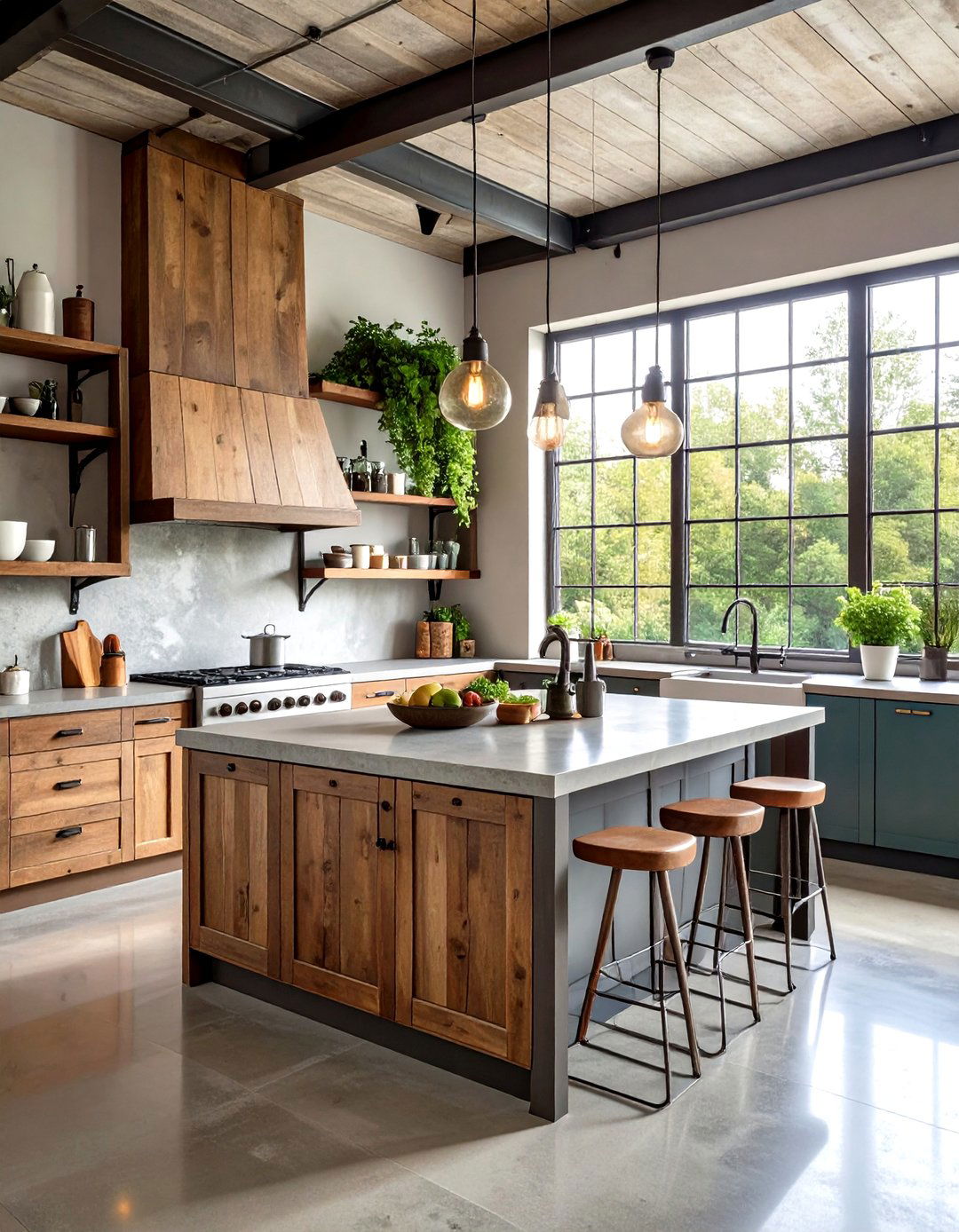
This bold design approach combines weathered wood elements with raw industrial materials to create a distinctive urban-meets-country aesthetic. Reclaimed wood cabinets pair with steel-framed glass doors, while concrete countertops feature integrated stainless steel sinks and industrial-style faucets. Exposed brick walls or metal tile backsplashes provide textural interest, complemented by open shelving constructed from iron pipe and reclaimed wood planks. Edison bulb lighting fixtures suspended from black metal frames illuminate the space with warm, ambient light. The color palette emphasizes charcoal grays, warm browns, and matte black accents, creating dramatic contrast throughout the kitchen. This style particularly appeals to urban loft dwellers or those seeking to blend rustic warmth with contemporary edge in suburban settings.
5. Cottage Style Rustic Kitchen with Painted Wood Finishes
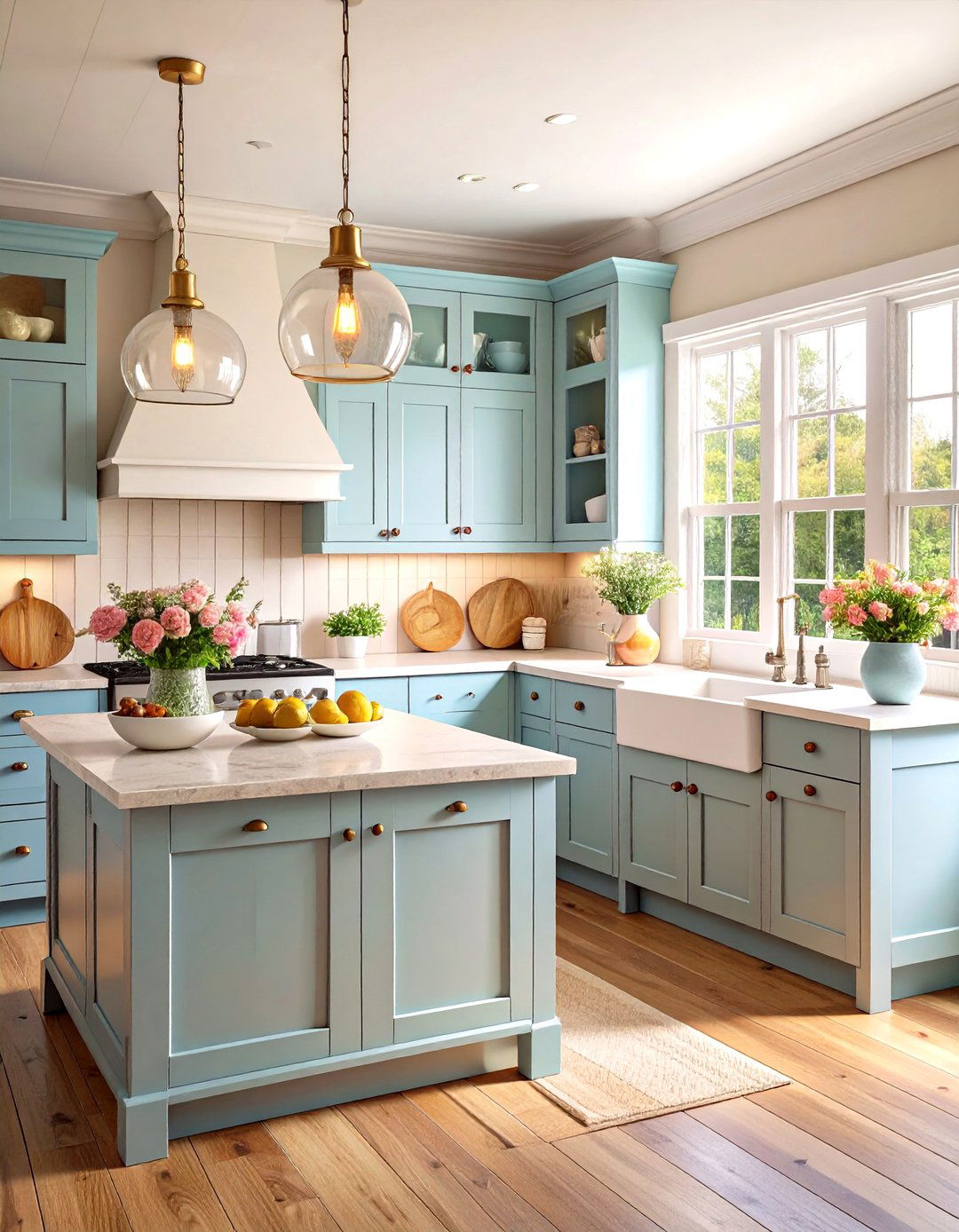
The charming cottage rustic kitchen features painted wood cabinets in soft pastels or distressed whites, creating a light and airy atmosphere while maintaining rustic character. Beadboard paneling extends partway up the walls, topped with simple chair rail molding and finished with subtle floral or striped wallpaper. Open shelving displays vintage dishware and botanical collections, while fabric skirts beneath farmhouse sinks add feminine touches to the practical workspace. Marble or butcher-block countertops provide durable work surfaces, complemented by subway tile backsplashes with colored grout for visual interest. Vintage-inspired lighting fixtures, including glass globe pendants or wrought iron chandeliers, enhance the romantic cottage atmosphere. This design celebrates the beauty of lived-in comfort through carefully curated vintage accessories and soft, welcoming color palettes.
6. Scandinavian Rustic Kitchen with Light Woods and Minimalist Touches
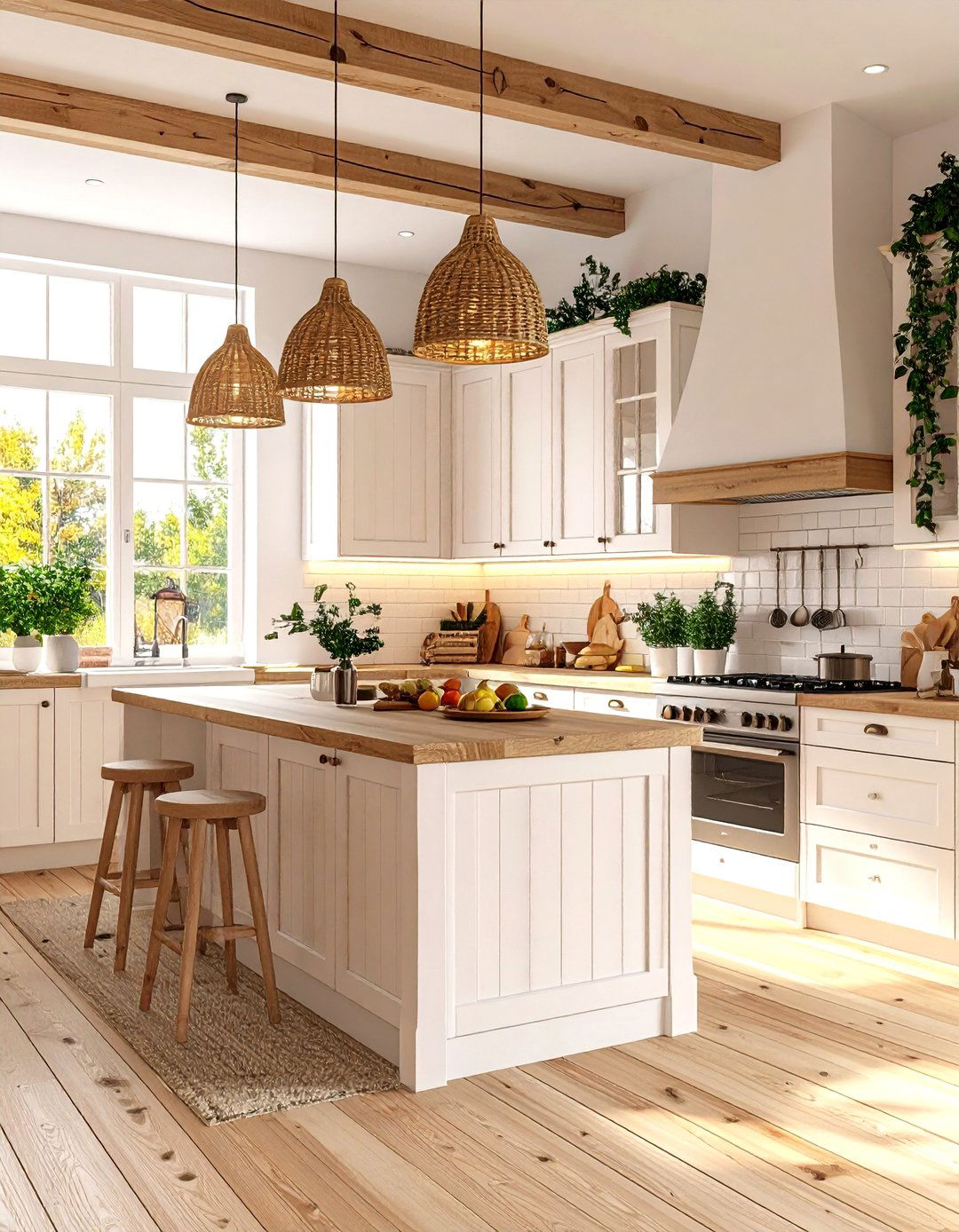
This refined approach to rustic kitchen design emphasizes light-colored woods, particularly birch and pine, combined with clean lines and functional simplicity. White or pale gray cabinets feature simple slab doors with minimal hardware, while light wood accents appear in open shelving, cutting boards, and decorative elements. The design maintains rustic authenticity through natural textures and organic shapes, including curved island edges and rounded cabinet details. Large windows maximize natural light, essential to the Scandinavian aesthetic, while pendant lights in natural materials like rattan or ceramic provide warm illumination. The color palette remains predominantly white and cream with natural wood tones, creating a serene and uncluttered environment. This style perfectly balances rustic warmth with Nordic functionality, appealing to those who appreciate understated elegance and sustainable design principles.
7. Dark Wood Rustic Kitchen with Rich Stained Finishes
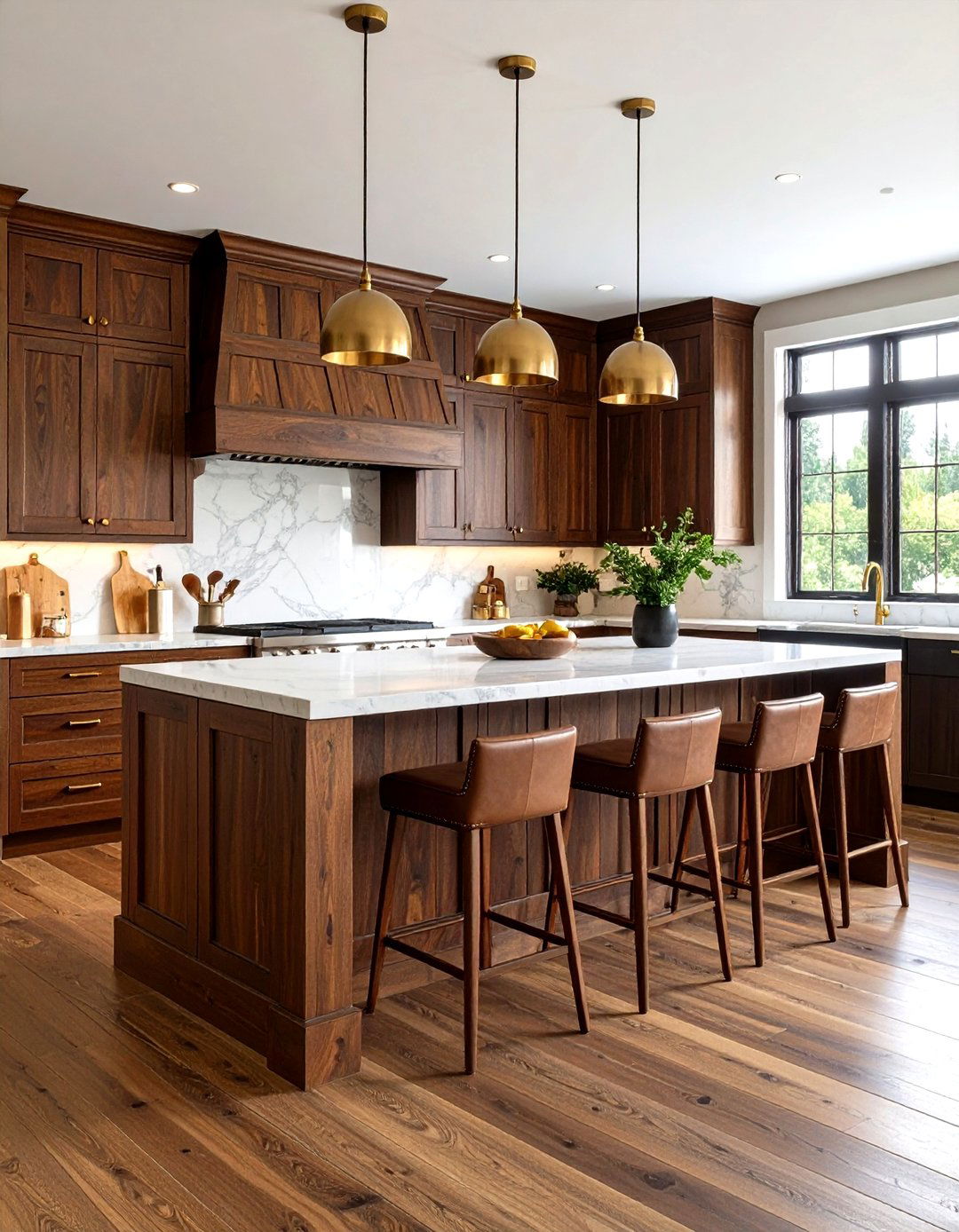
This sophisticated rustic kitchen design embraces the dramatic beauty of dark-stained wood cabinetry in walnut, mahogany, or ebony finishes. The rich cabinet tones pair beautifully with light-colored countertops in marble, quartzite, or butcher block to create striking visual contrast throughout the space. Brass or bronze hardware adds warmth and elegance, while pendant lighting with warm-toned bulbs prevents the darker elements from feeling too heavy or imposing. Stone accent walls in neutral tones provide textural interest without competing with the dramatic cabinetry. This design often incorporates leather bar stools and vintage copper accessories to enhance the sophisticated rustic atmosphere. The result is a kitchen that feels both cozy and elegant, perfect for those who appreciate the richness of natural wood and want to create a space with dramatic visual impact.
8. Rustic Kitchen with Exposed Ceiling Beams and Vaulted Architecture
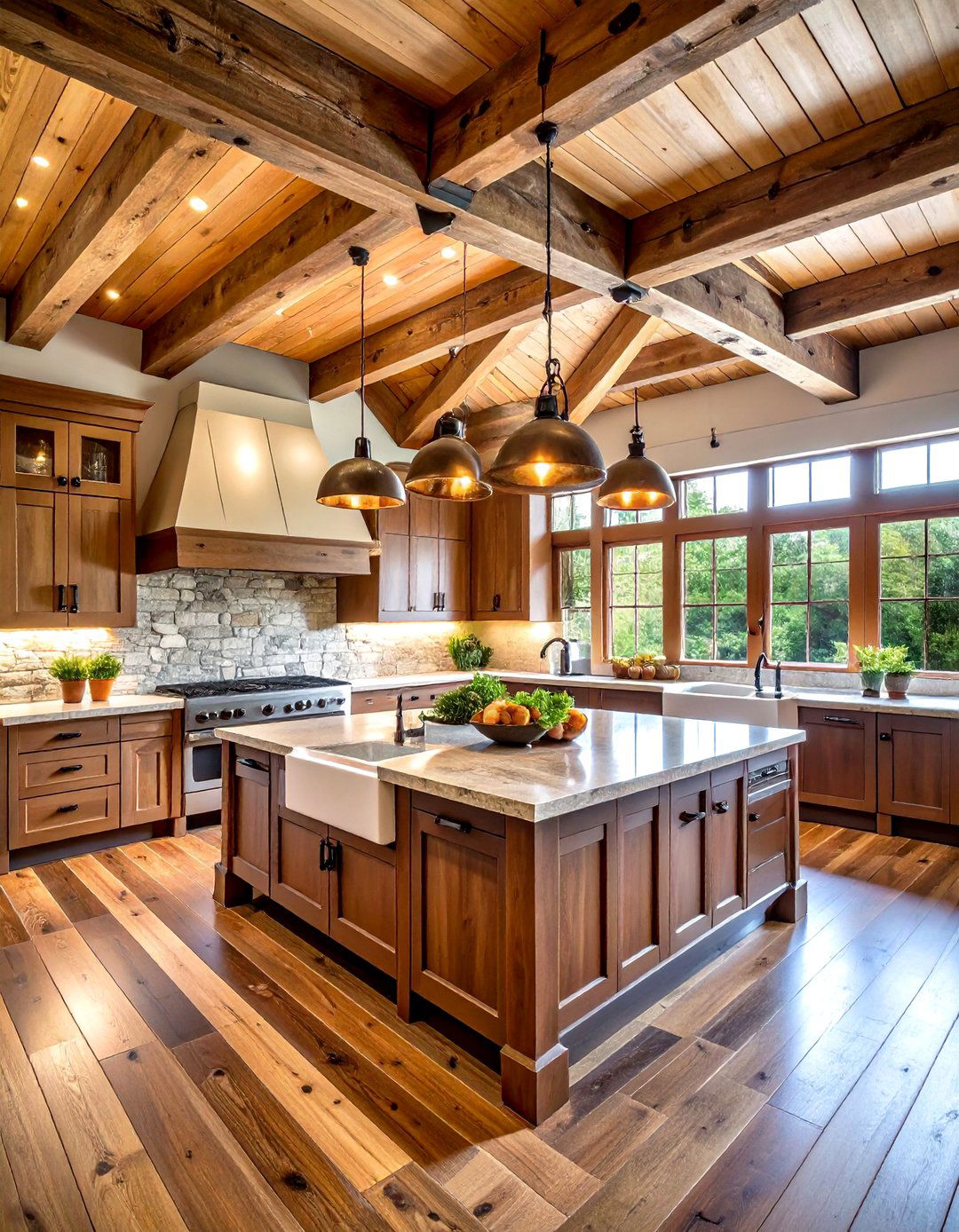
This architectural approach to rustic kitchen design celebrates structural elements as decorative features, particularly exposed wooden ceiling beams and vaulted spaces. Hand-hewn or reclaimed wood beams span the kitchen ceiling, creating visual interest and emphasizing the room's vertical space while adding authentic rustic character. The design typically features tall cabinets that draw the eye upward, complemented by hanging pot racks or pendant lights suspended from the beams. Natural materials throughout the space, including stone countertops and wide-plank flooring, harmonize with the overhead timber elements. The increased ceiling height allows for dramatic range hoods in copper or stone, becoming focal points that anchor the cooking area. This design works particularly well in great room layouts where the kitchen opens to living areas, creating a cohesive rustic atmosphere throughout the connected spaces.
9. Stone and Brick Rustic Kitchen with Textural Wall Treatments
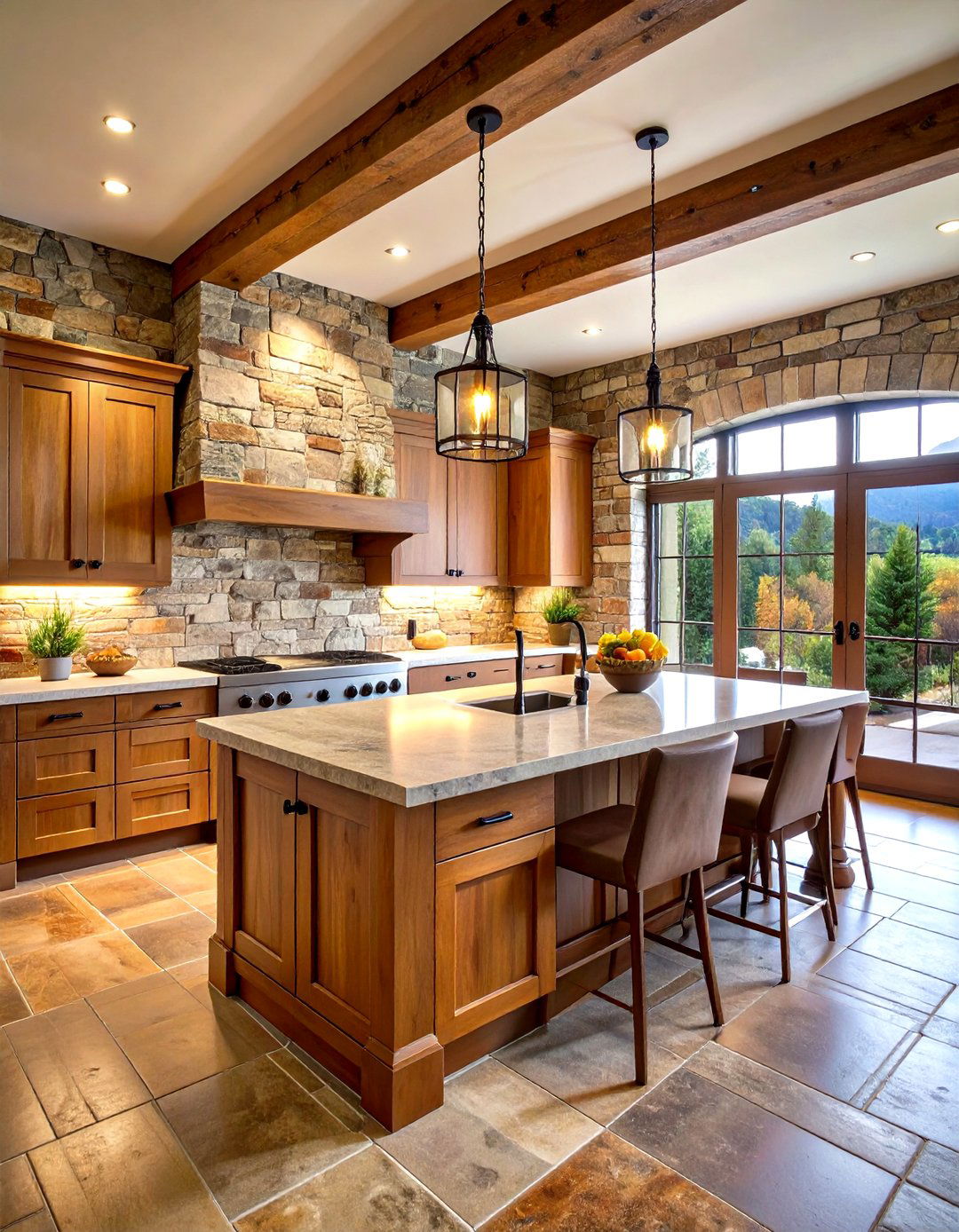
This design approach celebrates masonry materials as primary design elements, featuring natural stone or exposed brick walls that provide rich textural contrast to wood cabinetry. Fieldstone backsplashes behind ranges create stunning focal points, while brick accent walls add warmth and vintage character to the space. The design typically incorporates various stone types, from rough-hewn granite to smooth limestone, creating layers of natural texture throughout the kitchen. Wood cabinets in medium to dark stains complement the earthy stone tones, while wrought iron hardware and fixtures enhance the Old World aesthetic. Thick stone countertops or reclaimed wood surfaces provide durable work areas that harmonize with the masonry elements. This style particularly appeals to those who appreciate the permanence and authenticity of natural building materials and want to create kitchens with strong architectural presence.
10. White Rustic Kitchen with Weathered and Distressed Finishes

This bright interpretation of rustic kitchen design features predominantly white cabinetry with intentionally distressed or weathered finishes that reveal underlying wood tones. The design maintains rustic authenticity through carefully crafted imperfections, including worn edges, subtle color variations, and deliberately aged hardware. Shiplap or beadboard wall treatments in crisp white create textural interest without overwhelming the space, while natural wood elements in ceiling beams or open shelving provide warm contrast. Marble or quartz countertops with subtle veining complement the white palette while adding luxurious touches to the rustic foundation. Vintage-inspired lighting fixtures and accessories in galvanized metal or aged brass complete the weathered aesthetic. This style creates bright, airy kitchens that feel both fresh and authentically aged, perfect for coastal cottages or farmhouse settings where natural light enhances the distressed finishes.
11. Reclaimed Wood Rustic Kitchen with Sustainable Design Elements

This environmentally conscious rustic kitchen design centers around reclaimed barn wood and salvaged materials, creating authentic character while supporting sustainable building practices. Cabinets crafted from weathered barn siding showcase unique grain patterns and natural aging, while reclaimed wood countertops provide durable work surfaces with distinct patina. The design incorporates salvaged architectural elements, including vintage windows repurposed as cabinet doors and antique hardware that adds historical authenticity. Flooring often features reclaimed wide-plank boards with visible nail holes and weathered edges that tell stories of previous use. Open shelving constructed from reclaimed timbers displays vintage dishware and mason jar collections. This approach creates kitchens with genuine historical character while promoting environmental responsibility, appealing to homeowners who value both authentic aesthetics and sustainable living practices.
12. Rustic Kitchen Island Design with Multifunctional Central Workspace
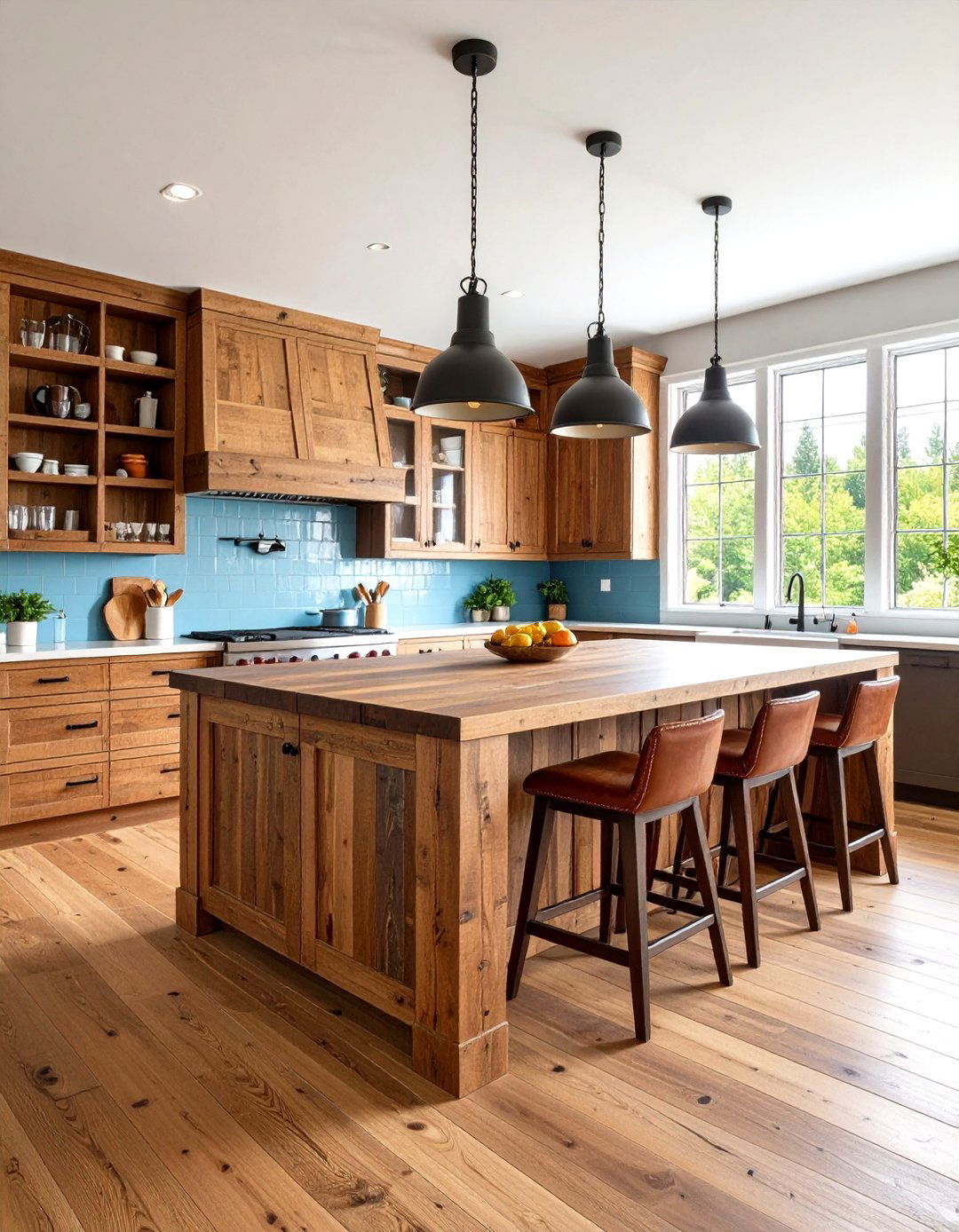
This design approach focuses on creating a substantial central island that serves as both workspace and gathering place, typically constructed from reclaimed wood or natural stone materials. The island features thick butcher-block tops or live-edge slabs that showcase natural wood grain, surrounded by rustic bar stools in leather or natural materials. Storage solutions include open shelving for displaying vintage dishware, wine storage, and deep drawers for kitchen essentials. The island often incorporates contrasting materials, such as a weathered wood base with marble or granite tops, creating visual interest while maintaining rustic authenticity. Pendant lighting specifically designed for the island workspace provides task illumination while contributing to the overall design aesthetic. This central feature becomes the heart of the rustic kitchen, facilitating both food preparation and social interaction while maximizing storage and functionality in the available space.
13. French Country Rustic Kitchen with Provincial Charm
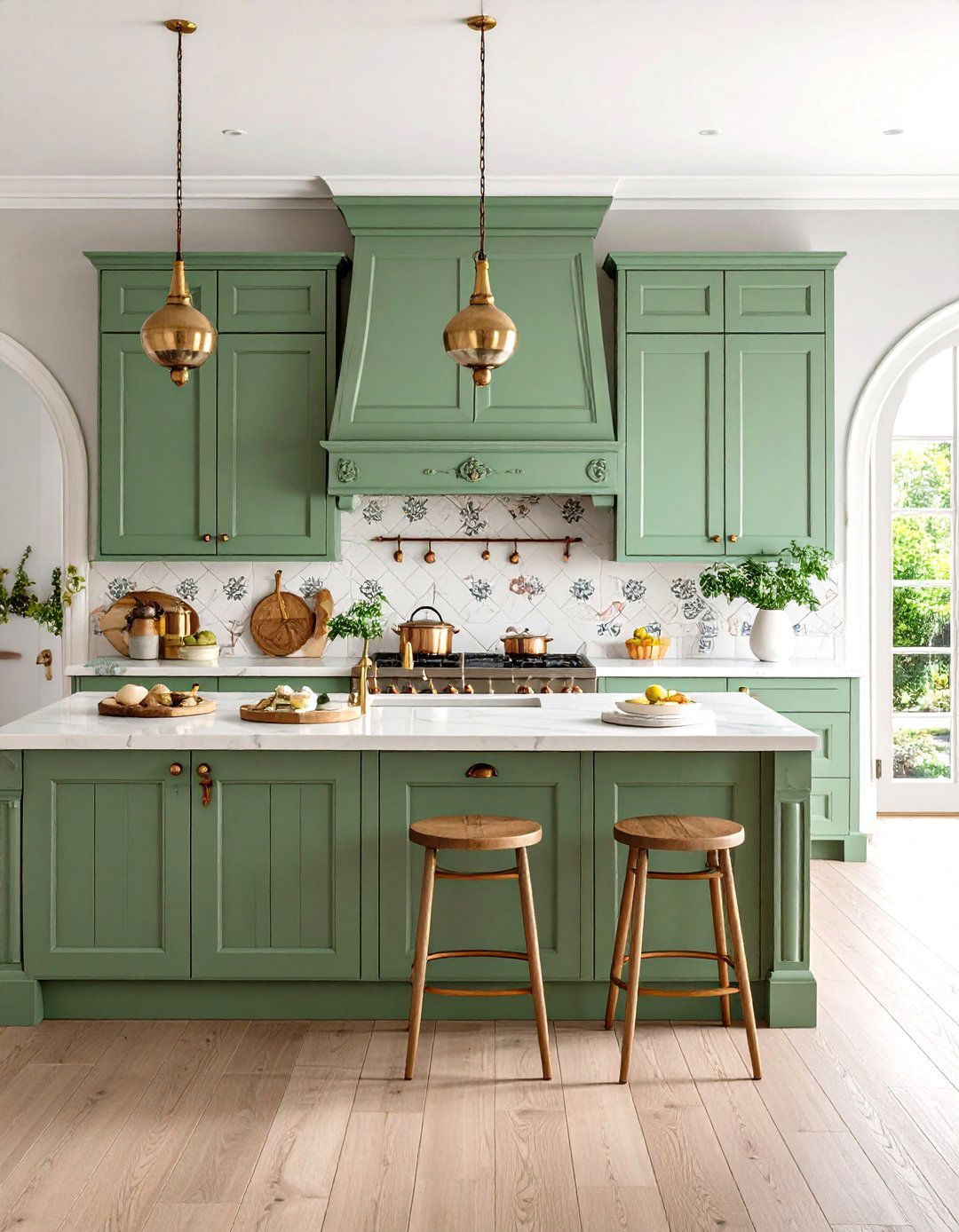
This elegant interpretation of rustic kitchen design draws inspiration from French farmhouse traditions, featuring carved wood details and sophisticated color palettes. Cabinetry often includes raised panel doors with decorative moldings, finished in soft blues, sage greens, or distressed whites that evoke the French countryside. Natural stone countertops, particularly limestone or travertine, provide authentic European character while offering practical work surfaces. The design incorporates vintage French accessories, including copper pots, ceramic crockery, and wrought iron pot racks that enhance the provincial atmosphere. Arched doorways and curved architectural details soften the rustic elements, while tile backsplashes in hand-painted or subway patterns add color and texture. This style creates kitchens that feel both rustic and refined, appealing to those who appreciate European elegance combined with countryside charm and functionality.
14. Rustic Kitchen Pantry Integration with Hidden Storage Solutions
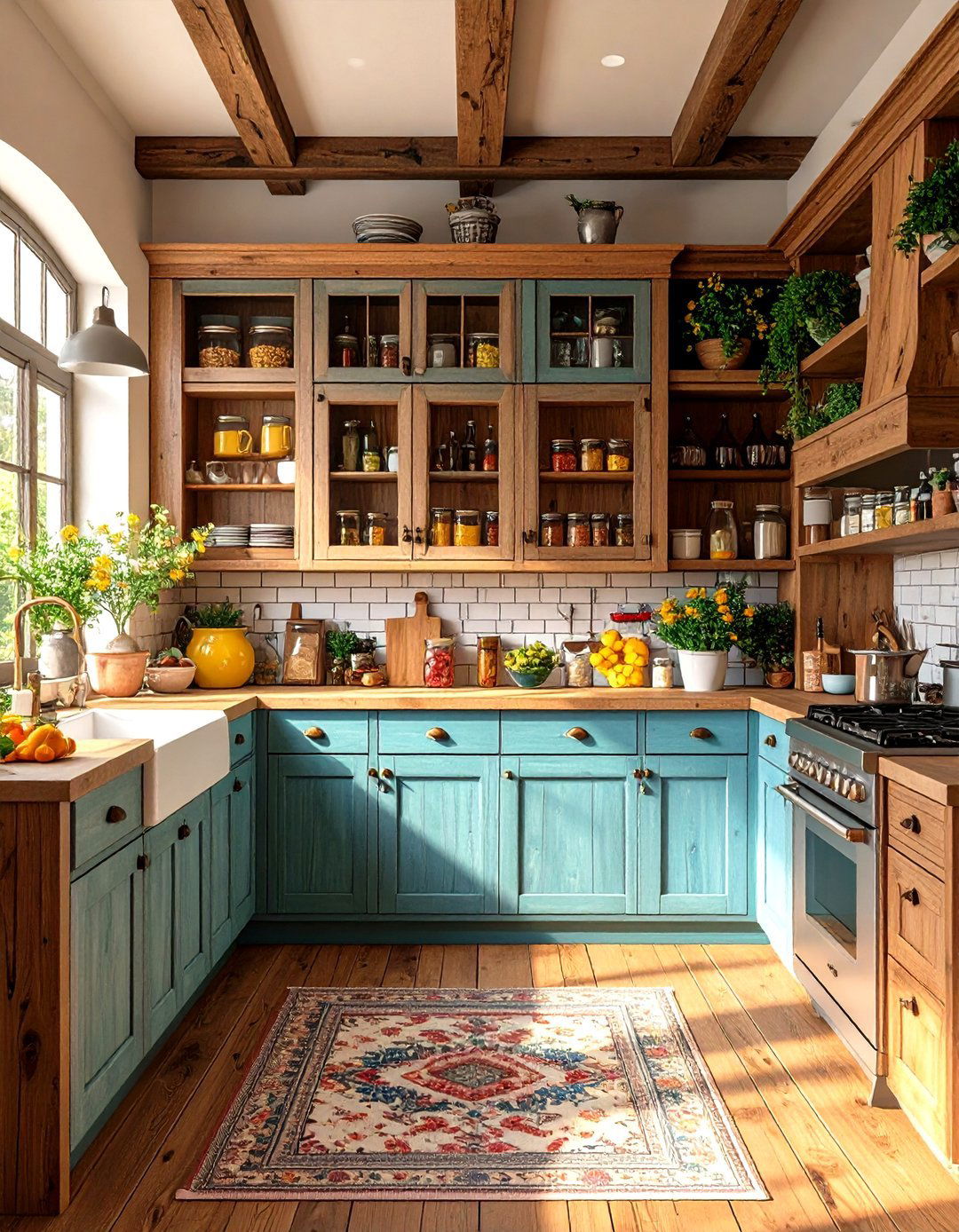
This design strategy incorporates extensive pantry storage seamlessly into the rustic kitchen aesthetic, often featuring floor-to-ceiling cabinetry that resembles antique armoires or pie safes. The pantry design maintains rustic character through weathered wood finishes, vintage-style hardware, and traditional proportions while maximizing storage efficiency. Hidden appliances, including refrigerator panels that match surrounding cabinetry, preserve the authentic rustic appearance while providing modern convenience. Open shelving sections display vintage containers and preserving jars, while closed storage conceals everyday items and modern appliances. The integration often includes specialized storage for bulk items, cookbooks, and seasonal dishware, all contained within cabinets that appear to be individual furniture pieces. This approach creates highly functional kitchens that maintain rustic charm while accommodating contemporary storage needs and organized living preferences.
15. Outdoor Rustic Kitchen with Natural Weather-Resistant Materials
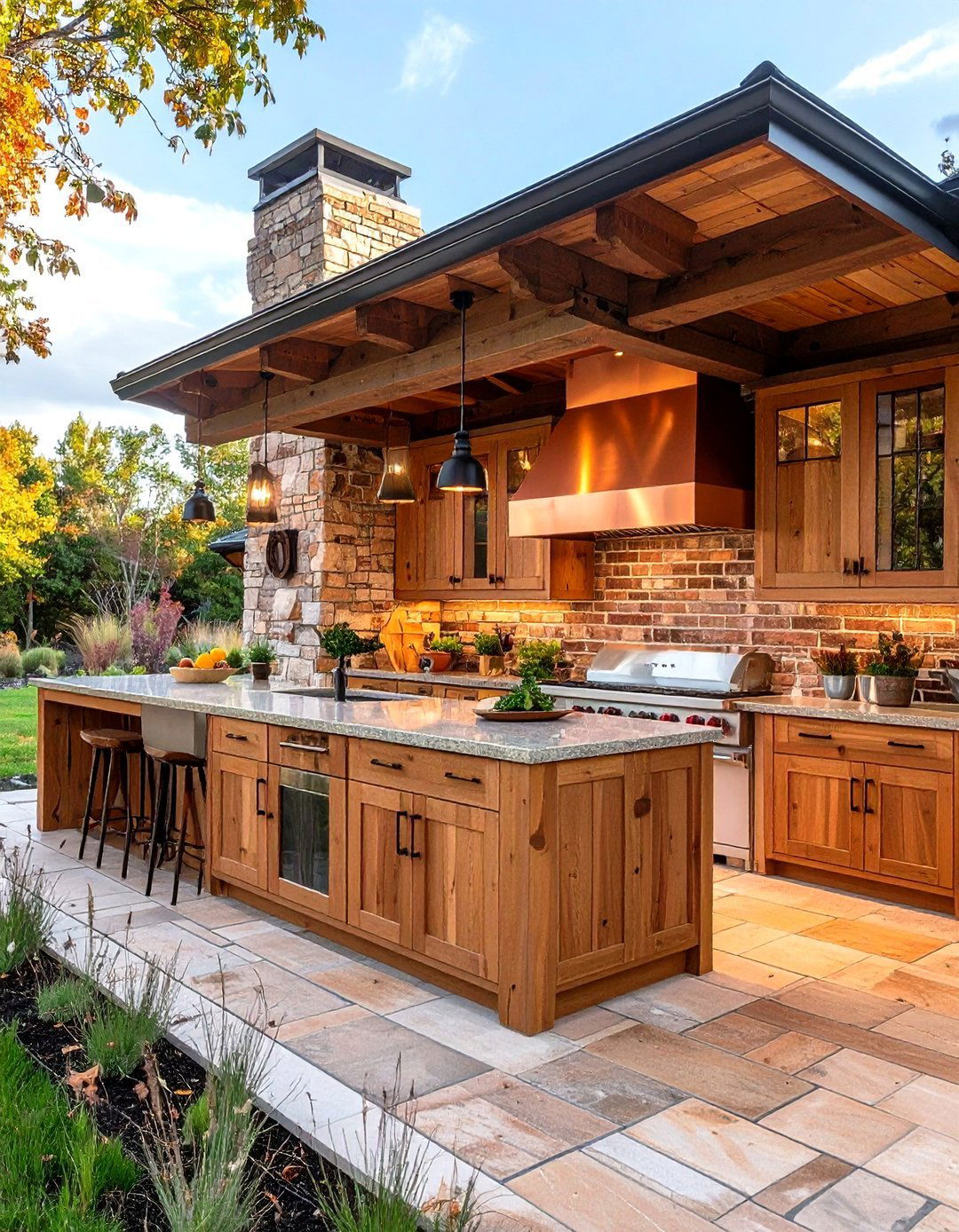
This design extends rustic kitchen concepts to outdoor living spaces, utilizing weather-resistant materials that maintain authentic character while withstanding the elements. Stone or brick construction provides durable foundations for outdoor cooking areas, while cedar or teak cabinetry offers natural weather resistance with beautiful aging characteristics. The design typically includes substantial range hoods in copper or stone, outdoor-rated appliances, and durable countertops in granite or concrete that handle temperature fluctuations. Natural materials like flagstone or brick flooring provide slip-resistant surfaces that harmonize with rustic design principles. Built-in storage solutions include wine refrigeration, outdoor dish storage, and weatherproof cabinets for entertaining essentials. This style creates seamless indoor-outdoor living experiences, perfect for those who enjoy al fresco dining and want to extend their rustic kitchen aesthetic into garden or patio settings while maintaining full cooking functionality.
16. Small Cabin Rustic Kitchen with Space-Efficient Design Solutions

This compact design approach maximizes functionality within limited square footage while maintaining authentic rustic character throughout the space. Vertical storage solutions include floor-to-ceiling cabinets and open shelving that draw the eye upward, creating an illusion of greater space while providing essential storage. The design often features multipurpose elements, such as kitchen islands that serve as both prep areas and dining tables, or breakfast bars that extend from existing countertops. Light-colored wood finishes and strategic lighting placement help small spaces feel larger while preserving rustic warmth. Compact appliances designed for cabin use maintain modern convenience without overwhelming the intimate scale. This style proves that rustic charm doesn't require extensive square footage, creating cozy and functional kitchens perfect for vacation cabins, tiny homes, or urban apartments where space efficiency and character must coexist harmoniously.
17. Luxury Rustic Kitchen with High-End Finishes and Custom Details
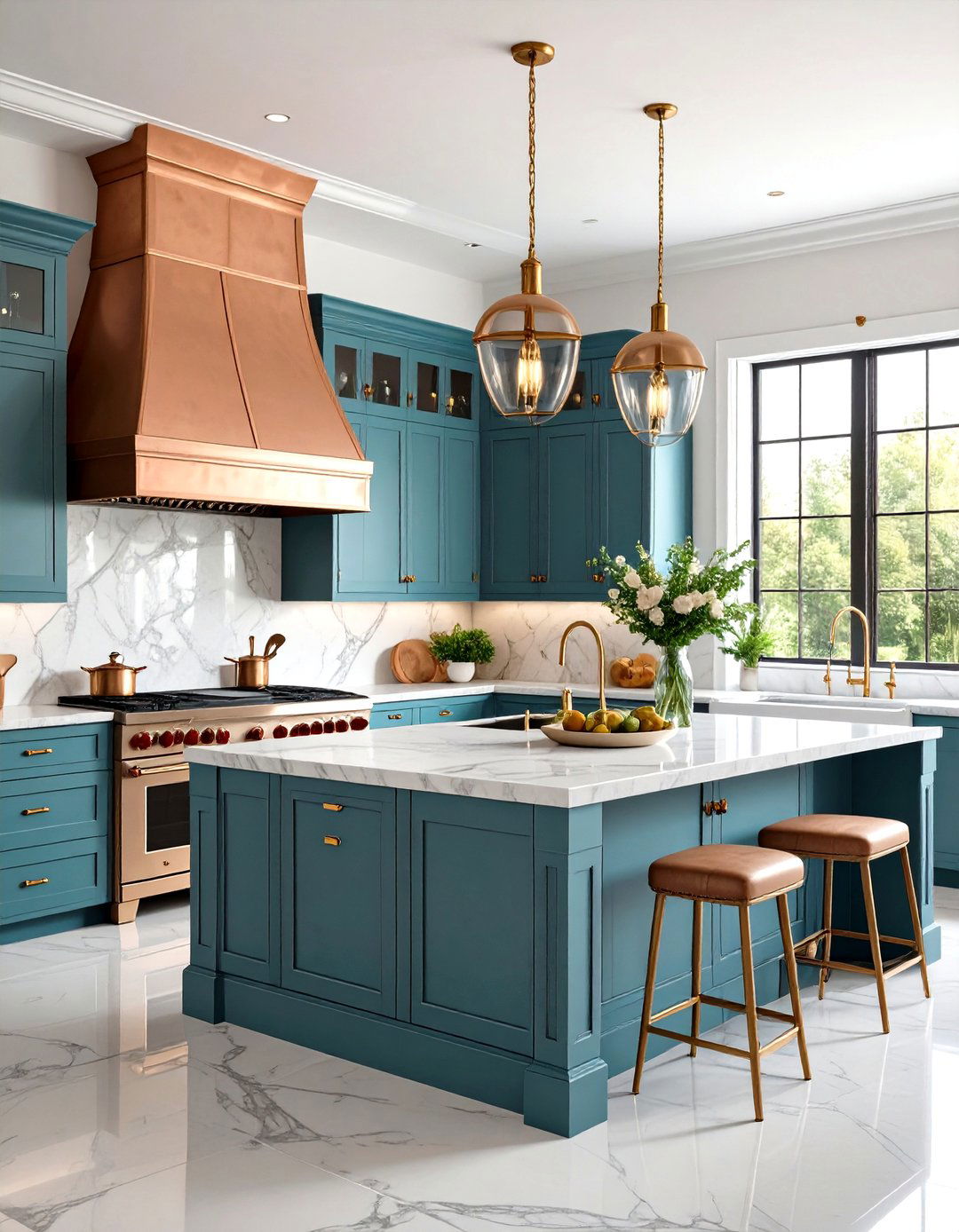
This sophisticated approach to rustic kitchen design incorporates premium materials and custom craftsmanship while maintaining authentic rustic character. Hand-carved cabinetry details, custom range hoods in hammered copper or natural stone, and artisan-crafted tile work elevate the rustic aesthetic to luxury standards. High-end appliances feature custom panels that seamlessly integrate with surrounding cabinetry, while professional-grade cooking equipment provides restaurant-quality functionality. Natural stone countertops in exotic varieties, such as book-matched marble or rare granite, create stunning focal points throughout the space. Custom lighting fixtures, often handcrafted by local artisans, provide both task and ambient illumination while contributing to the overall design narrative. This style demonstrates that rustic design can achieve the highest levels of luxury while maintaining authenticity, appealing to those who appreciate fine craftsmanship and premium materials within rustic design frameworks.
18. Vintage Industrial Rustic Kitchen with Antique Machinery Elements
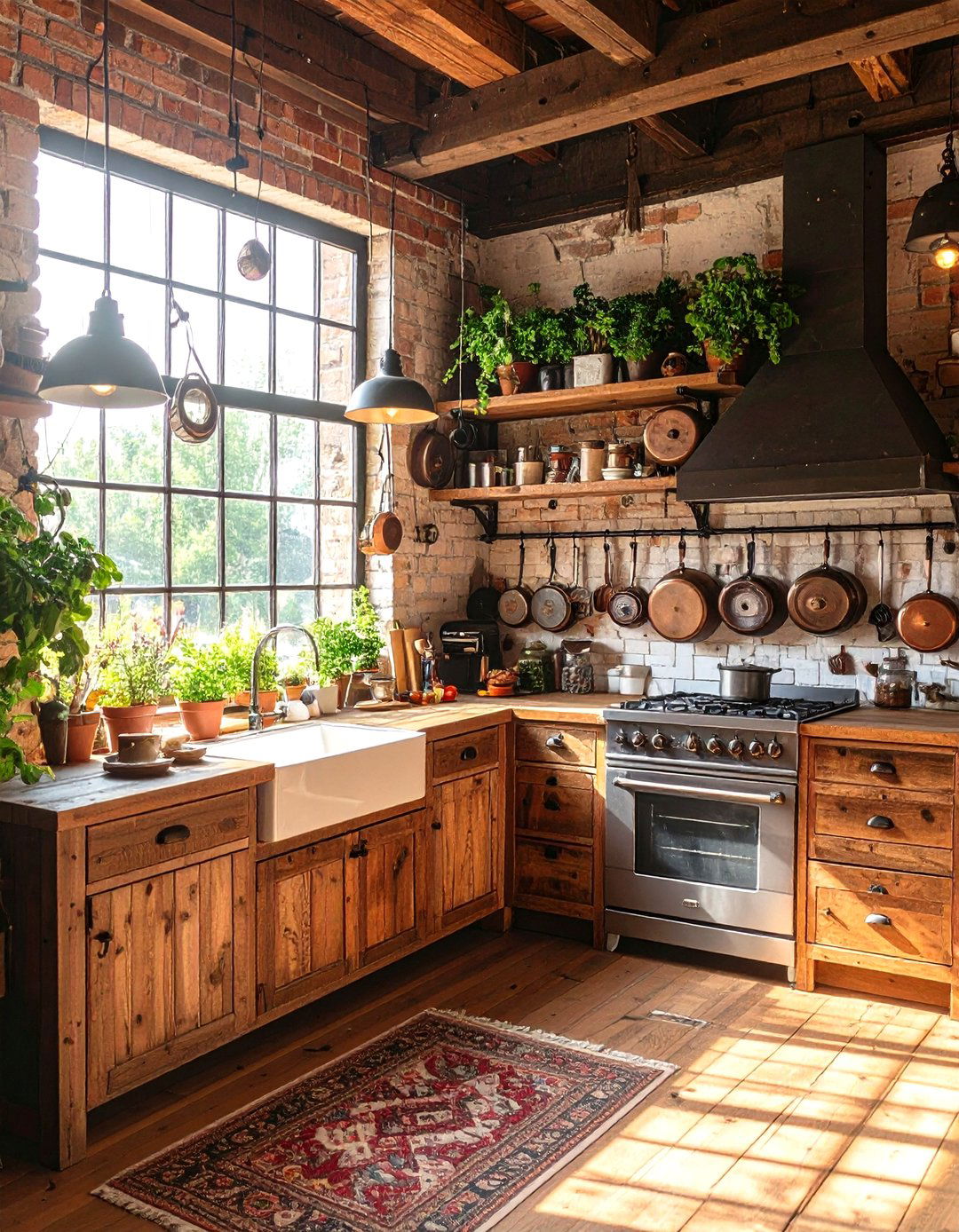
This unique design approach incorporates authentic antique industrial elements alongside traditional rustic materials, creating kitchens with distinctive character and historical significance. Repurposed machinery parts become functional elements, such as old pulleys converted to pot racks or vintage factory carts transformed into mobile kitchen islands. The design features exposed metal ductwork, vintage industrial lighting fixtures, and reclaimed factory windows that flood the space with natural light. Weathered wood cabinetry pairs with metal accents in aged brass or raw steel, while concrete or butcher-block countertops provide durable work surfaces. Antique scales, vintage signage, and repurposed industrial containers serve as both functional elements and decorative accessories. This style appeals to those who appreciate industrial history and want to create kitchens that celebrate American manufacturing heritage while providing thoroughly modern cooking facilities and storage solutions.
19. Rustic Kitchen with Live-Edge Wood Features and Natural Imperfections

This design philosophy celebrates the natural beauty of wood's organic forms, featuring live-edge countertops, shelving, and architectural elements that showcase trees' natural growth patterns. Live-edge slabs serve as stunning countertops or breakfast bars, with each piece unique in its natural curves and grain patterns. The design maintains rustic authenticity by preserving wood's natural imperfections, including knots, mineral streaks, and irregular edges that machine finishing would eliminate. Supporting cabinetry often features complementary wood species in more traditional forms, creating interesting textural contrasts throughout the space. Natural stone or tile backsplashes provide neutral backgrounds that allow the wood's beauty to take center stage. This approach creates kitchens that feel intimately connected to nature while providing all modern conveniences, appealing to those who appreciate organic design and want their kitchens to celebrate wood's natural artistry.
20. Transitional Cottage Rustic Kitchen with Modern Conveniences
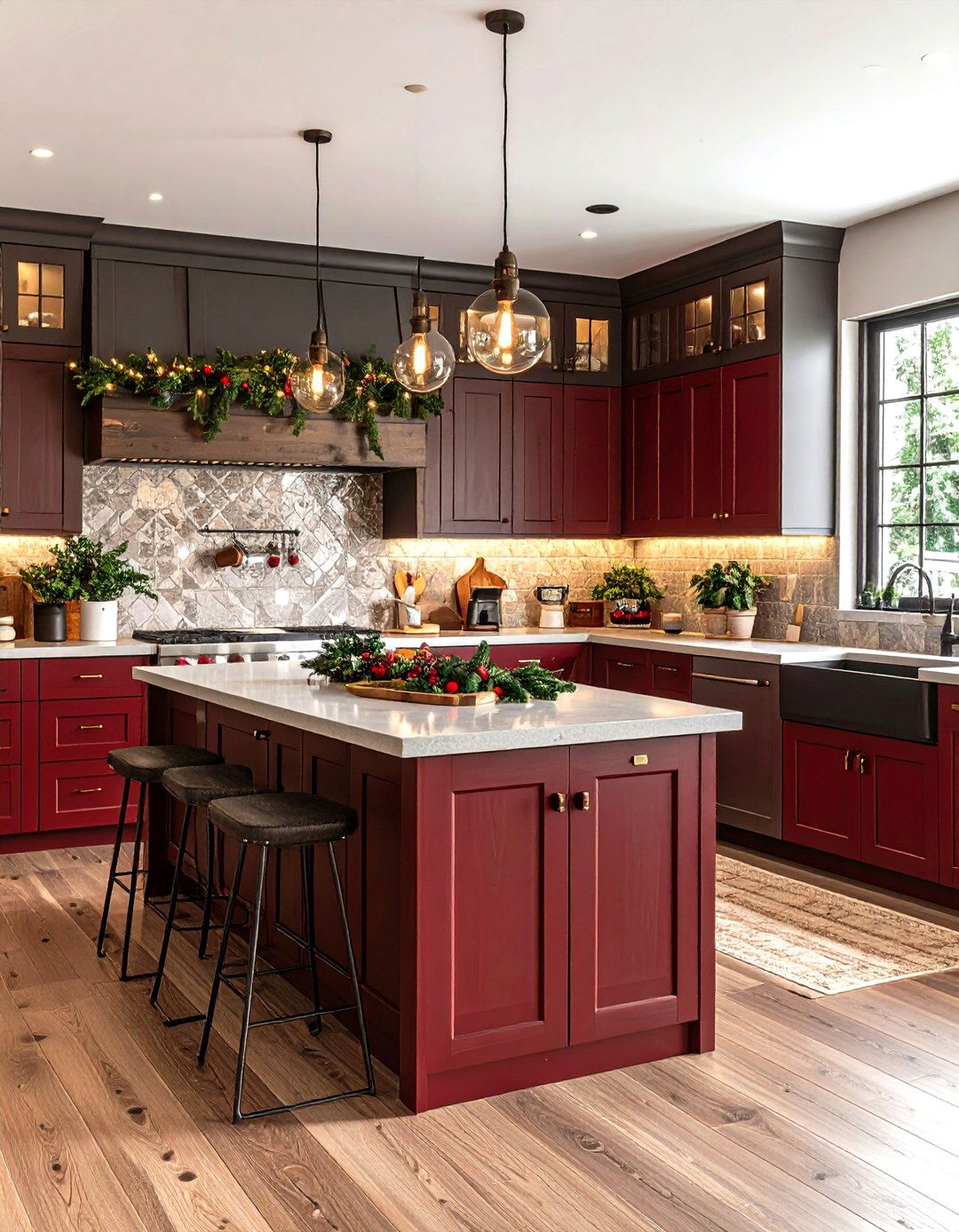
This contemporary evolution of rustic kitchen design blends cottage charm with transitional sophistication, featuring rich colors like mushroom gray, burgundy, and sage green alongside classic rustic elements. Dark wood cabinetry in walnut or cherry creates dramatic foundations, while handcrafted materials including zellige tiles and hand-painted patterns add artisanal character. The design incorporates modern conveniences seamlessly, including hidden appliances, smart storage solutions, and contemporary lighting fixtures that complement rather than compete with rustic elements. Natural materials like stone and reclaimed wood maintain authentic character while updated proportions and refined details create sophisticated appeal. This style bridges historical and contemporary design sensibilities, creating kitchens that feel both timeless and current. The approach appeals to homeowners who appreciate rustic warmth but want updated functionality and refined aesthetics that work equally well in historic properties and new construction.
Conclusion:
Rustic kitchen designs in 2025 offer incredible versatility, from traditional farmhouse aesthetics to contemporary interpretations that blend natural materials with modern convenience. These twenty design approaches demonstrate that rustic style can adapt to any lifestyle, budget, or space while maintaining authentic character. Whether you're drawn to weathered wood, natural stone, or vintage industrial elements, the key to successful rustic kitchen design lies in celebrating imperfection and embracing natural materials that tell compelling stories through their unique characteristics.


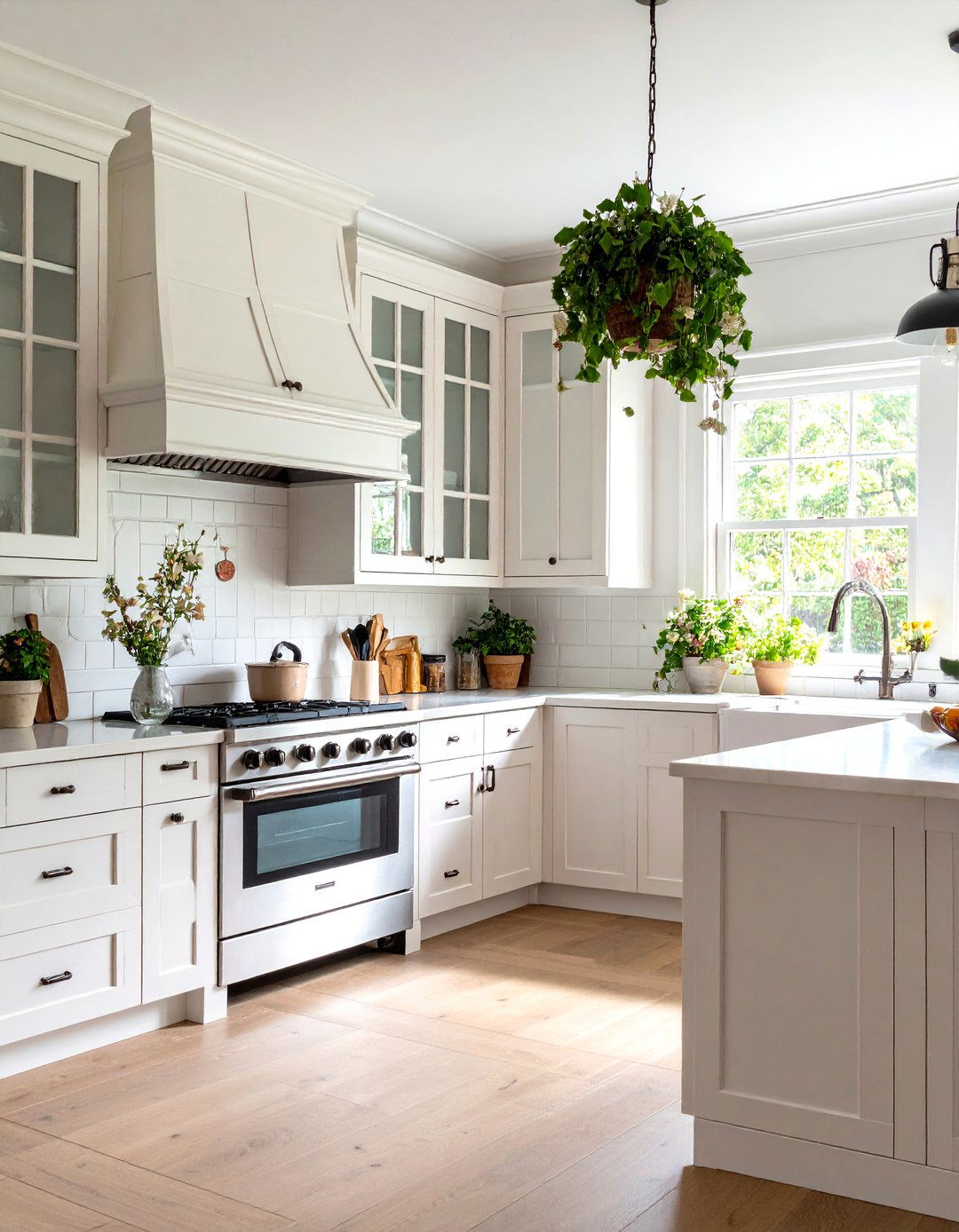
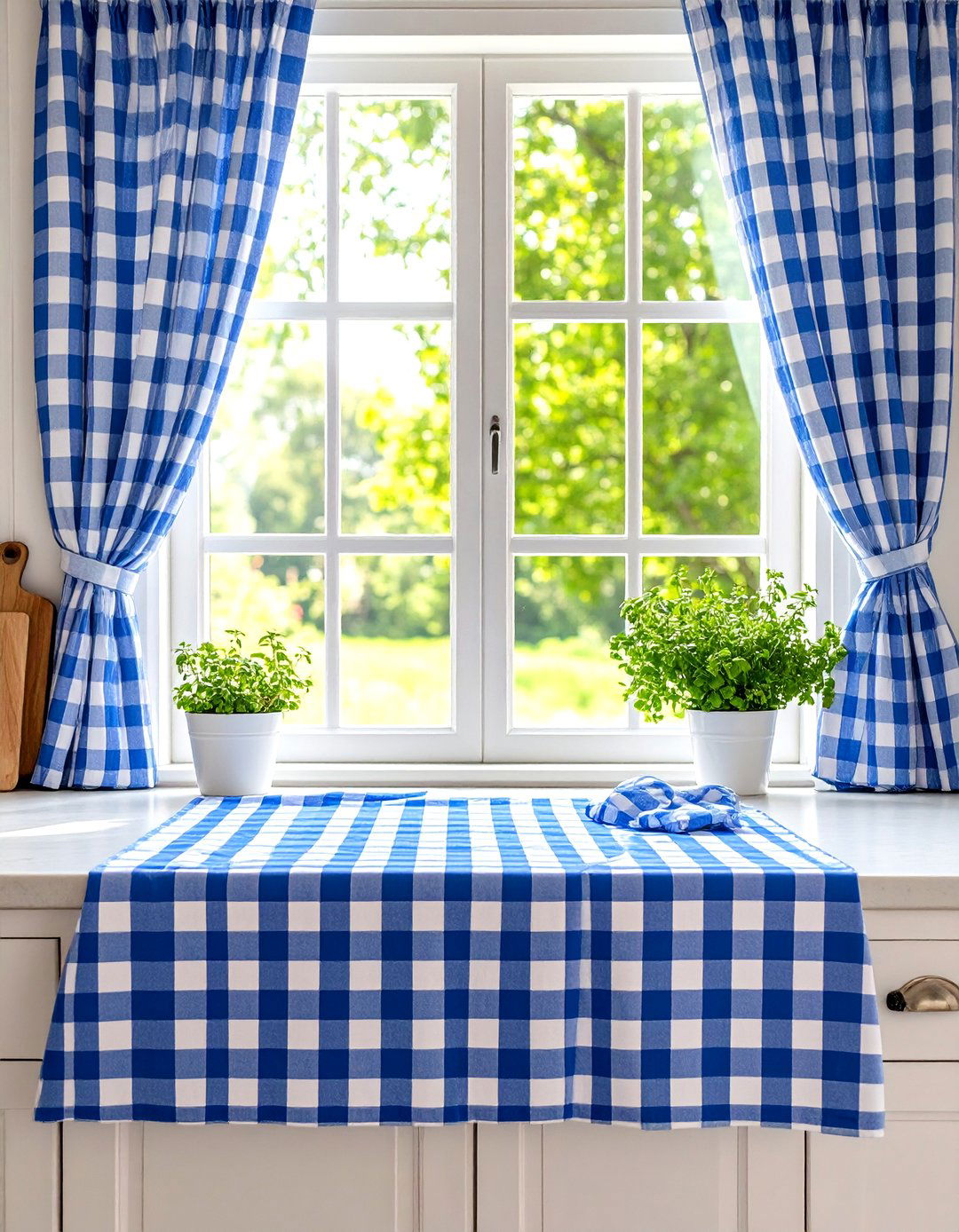

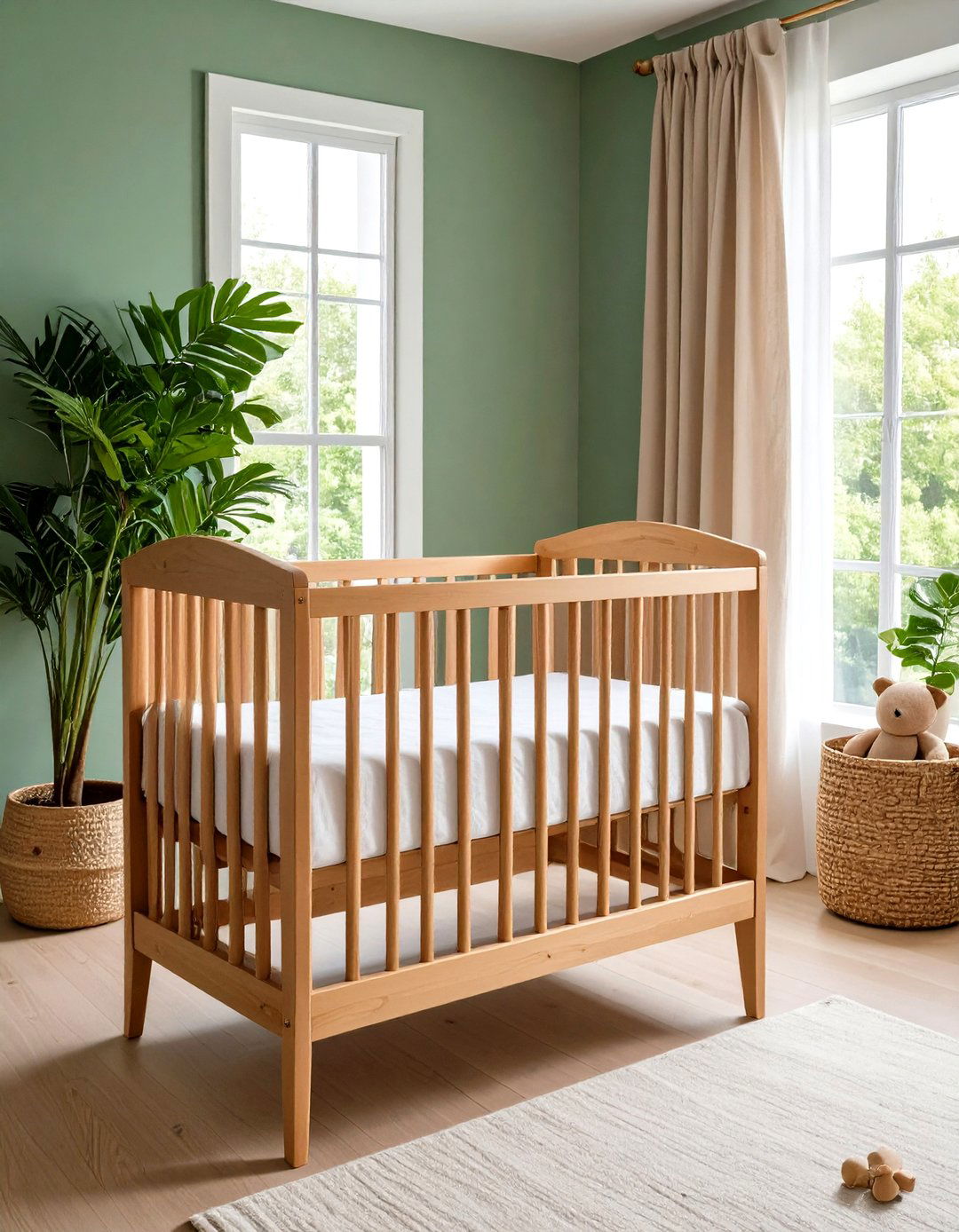
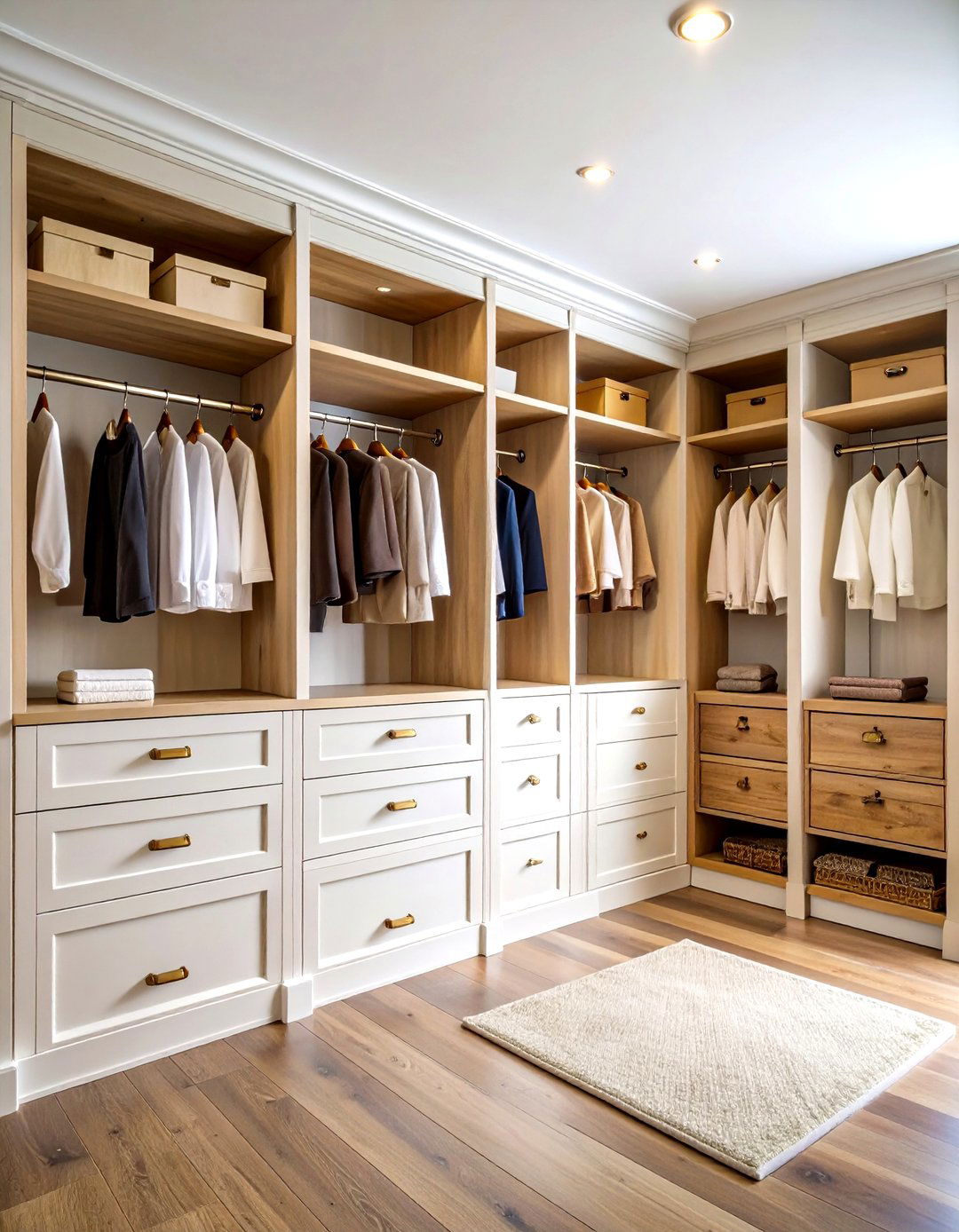
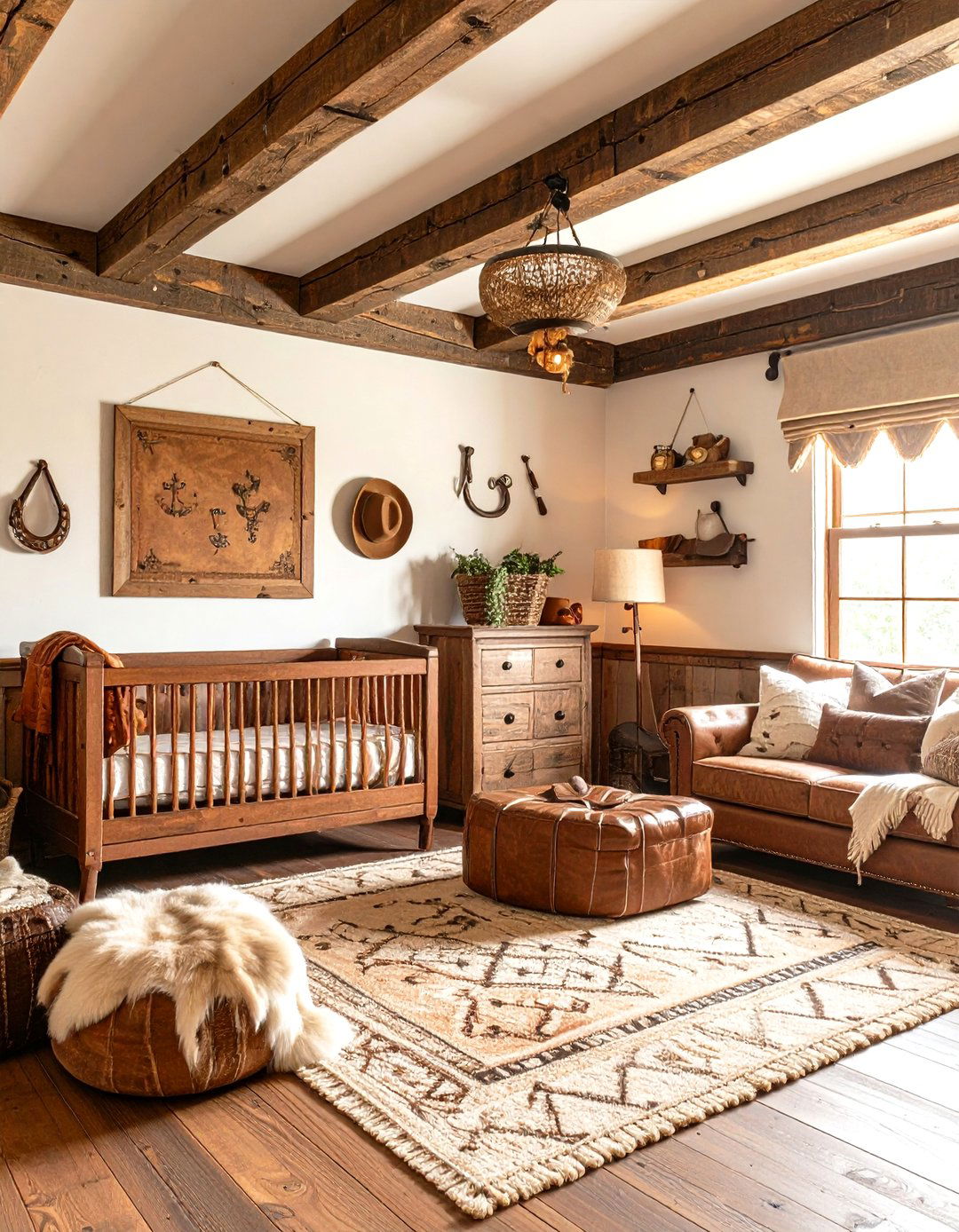
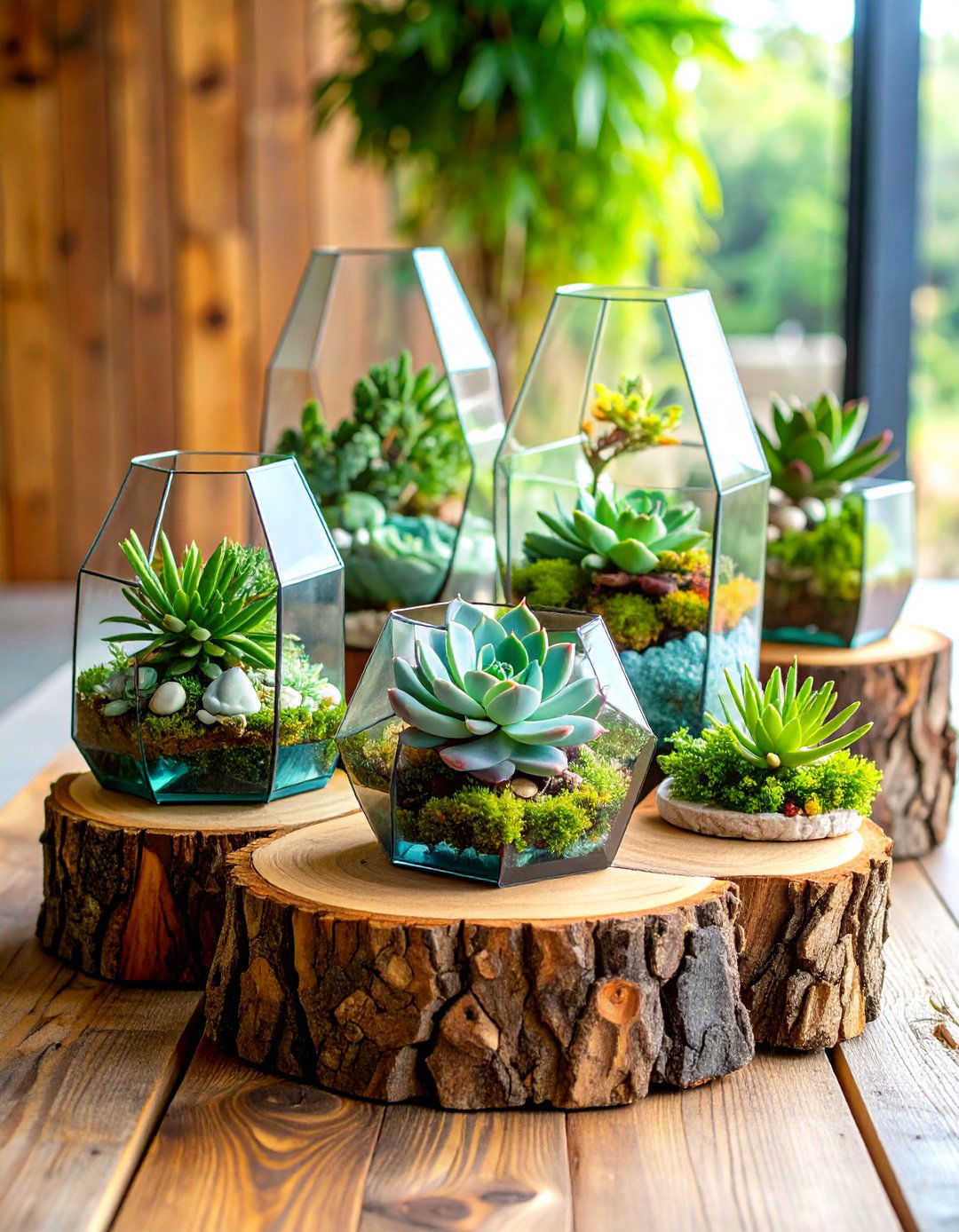


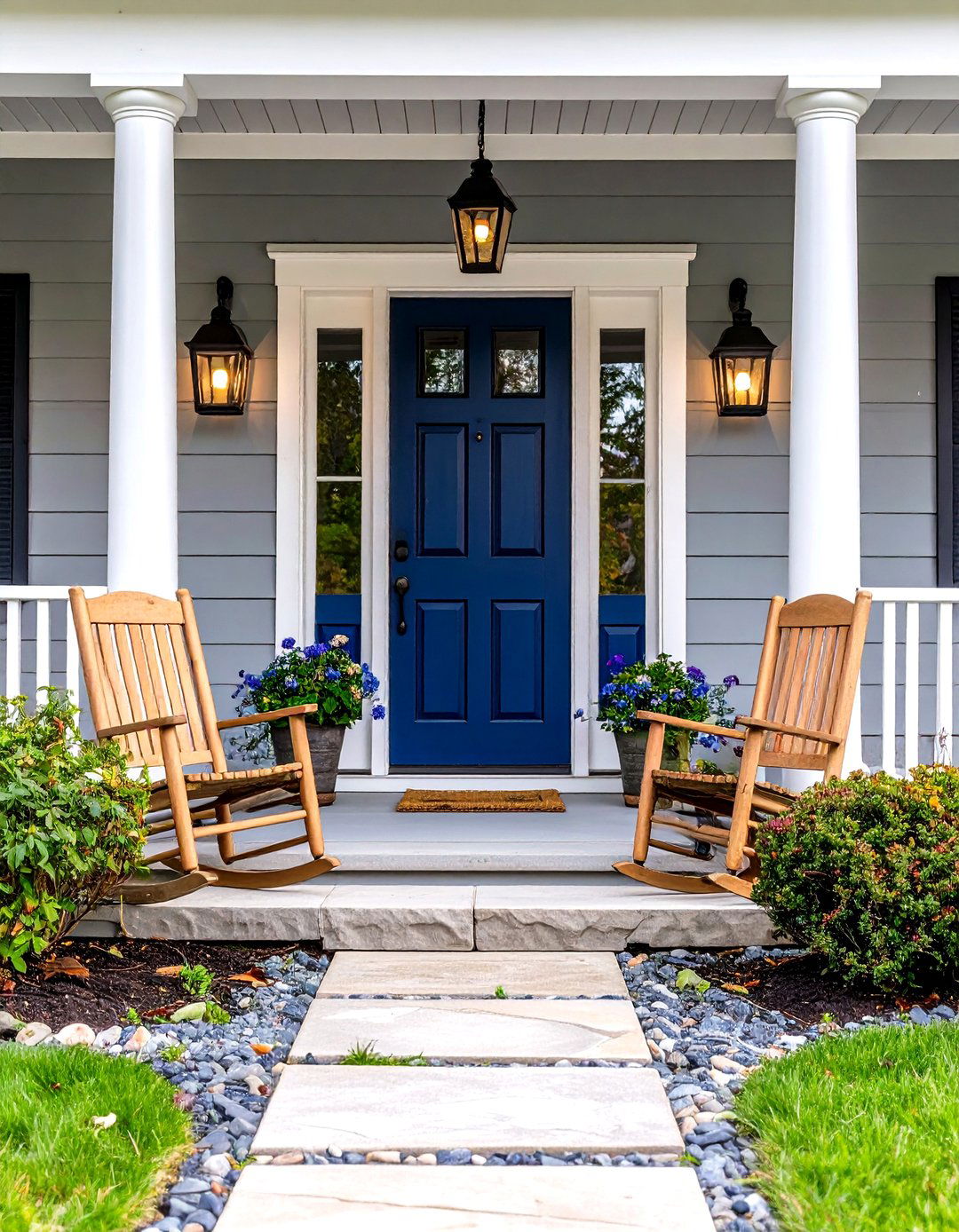
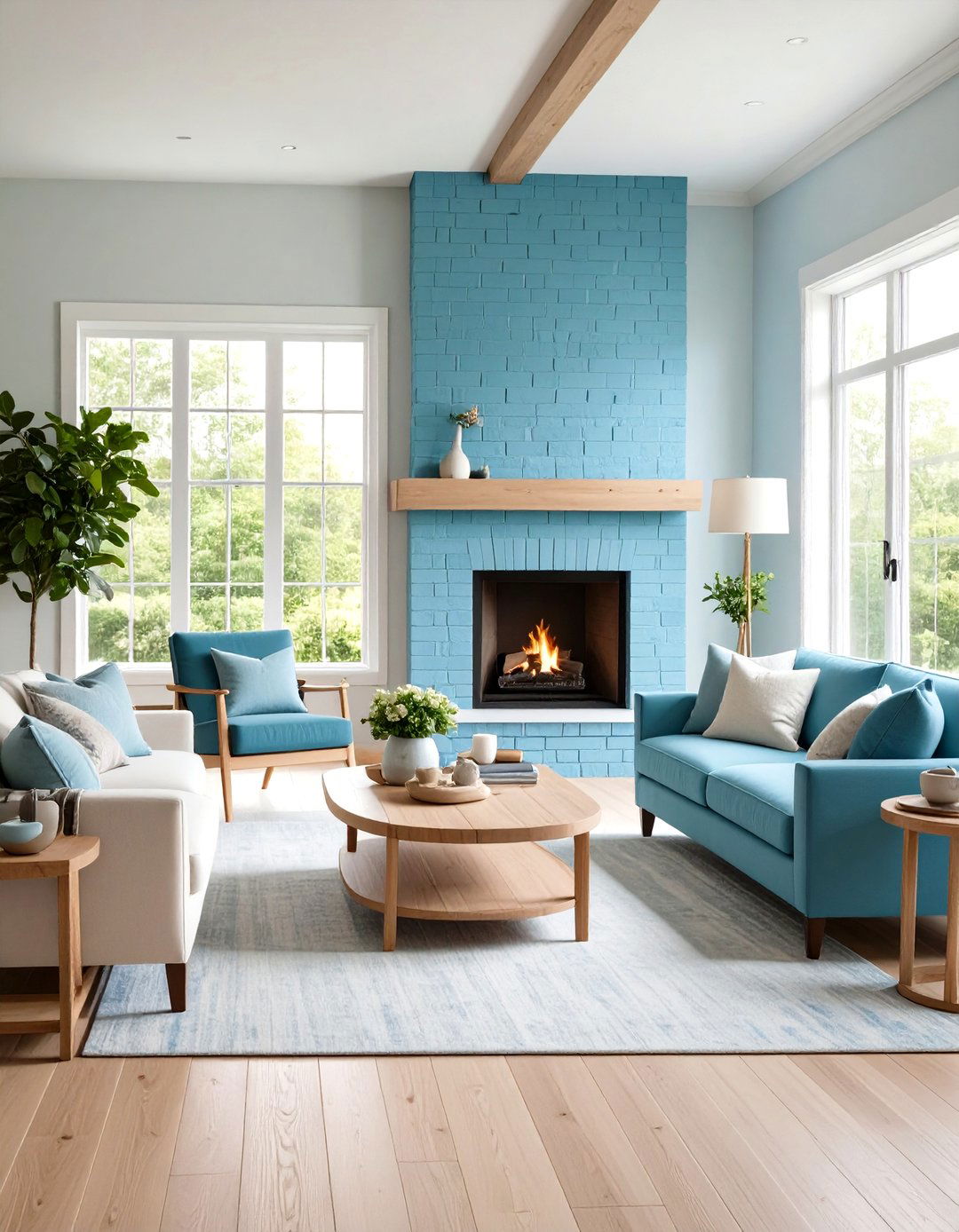

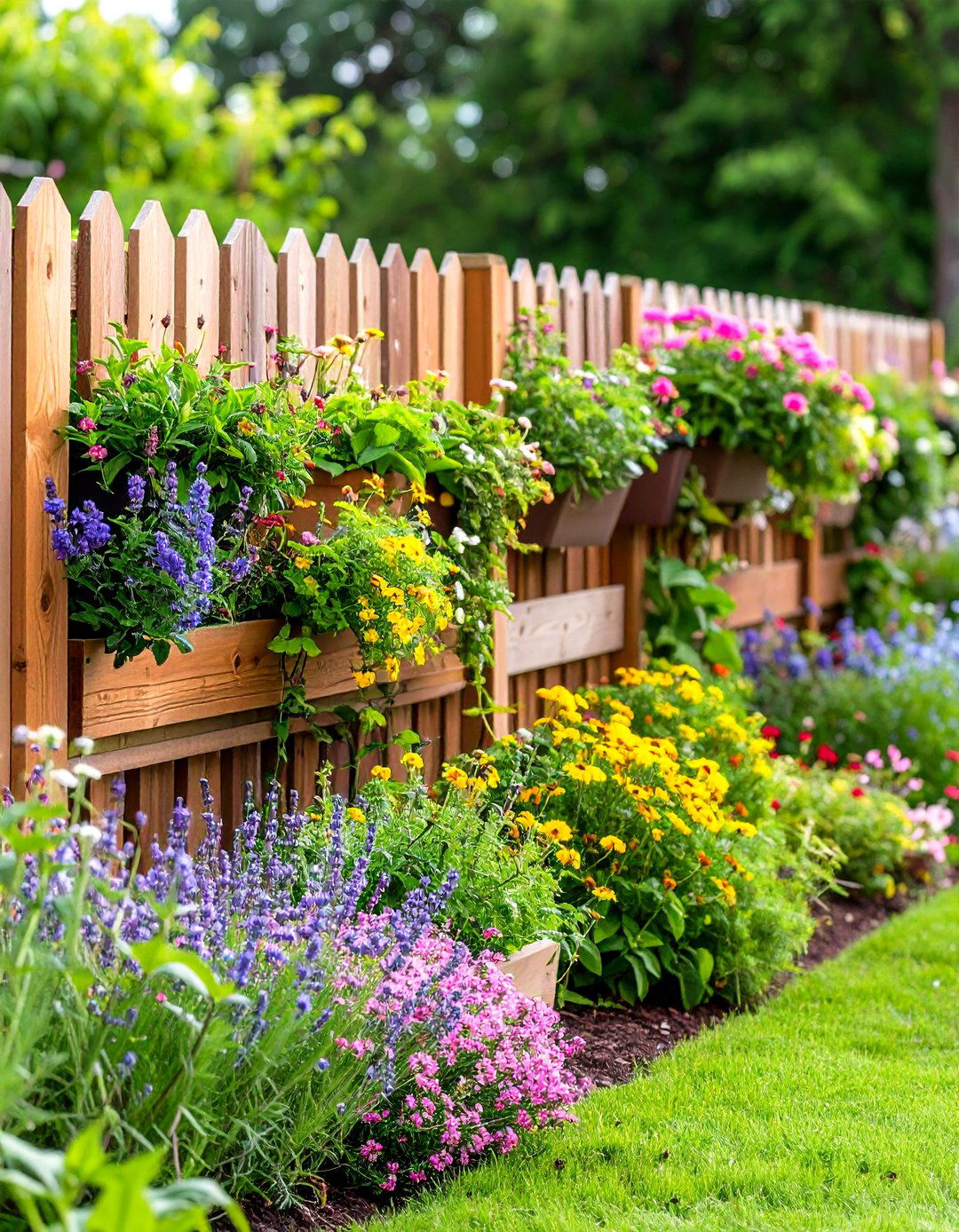
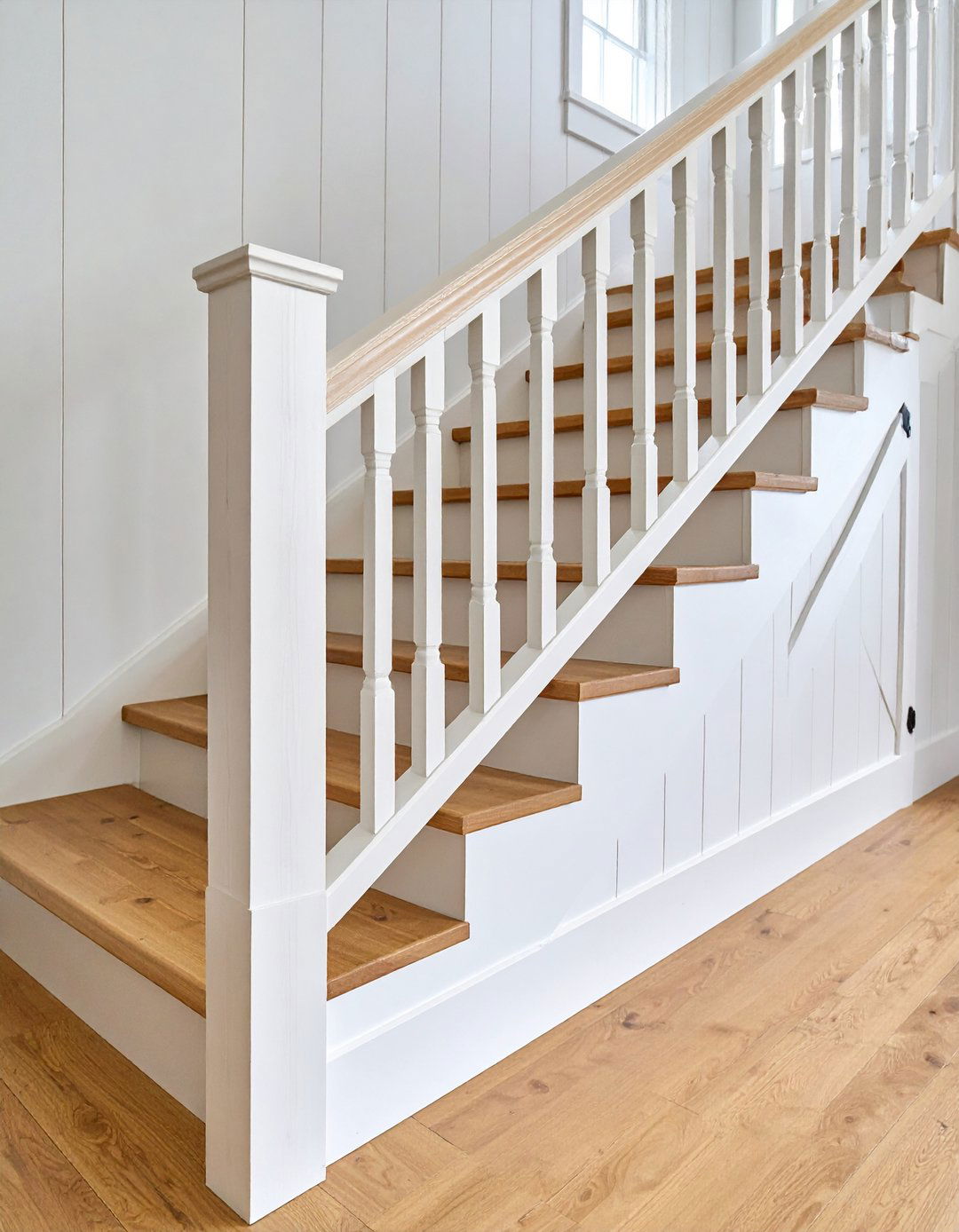
Leave a Reply